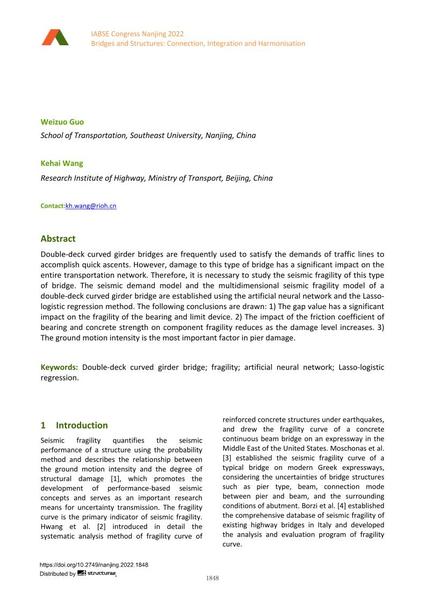Seismic Fragility of Double-Deck Curved Girder Bridge Based on Artificial Neural Network and Lasso-Logistic Regression

|
|
|||||||||||
Détails bibliographiques
| Auteur(s): |
Weizuo Guo
(School of Transportation, Southeast University, Nanjing, China)
Kehai Wang (Research Institute of Highway, Ministry of Transport, Beijing, China) |
||||
|---|---|---|---|---|---|
| Médium: | papier de conférence | ||||
| Langue(s): | anglais | ||||
| Conférence: | IABSE Congress: Bridges and Structures: Connection, Integration and Harmonisation, Nanjing, People's Republic of China, 21-23 September 2022 | ||||
| Publié dans: | IABSE Congress Nanjing 2022 | ||||
|
|||||
| Page(s): | 1848-1855 | ||||
| Nombre total de pages (du PDF): | 8 | ||||
| DOI: | 10.2749/nanjing.2022.1848 | ||||
| Abstrait: |
Double-deck curved girder bridges are frequently used to satisfy the demands of traffic lines to accomplish quick ascents. However, damage to this type of bridge has a significant impact on the entire transportation network. Therefore, it is necessary to study the seismic fragility of this type of bridge. The seismic demand model and the multidimensional seismic fragility model of a double-deck curved girder bridge are established using the artificial neural network and the Lasso- logistic regression method. The following conclusions are drawn: 1) The gap value has a significant impact on the fragility of the bearing and limit device. 2) The impact of the friction coefficient of bearing and concrete strength on component fragility reduces as the damage level increases. 3) The ground motion intensity is the most important factor in pier damage. |
||||
| Copyright: | © 2022 International Association for Bridge and Structural Engineering (IABSE) | ||||
| License: | Cette oeuvre ne peut être utilisée sans la permission de l'auteur ou détenteur des droits. |
||||
